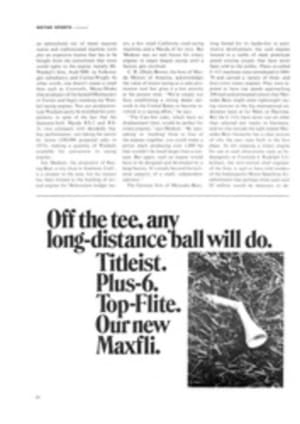
G. Washington dug here
For several years Union Camp Corporation, a cluster of forest-based industries, had been debating what to do with 49,000 acres it owned in the Dismal Swamp of Virginia. Sell the land to developers? Build a jetport on it? A racetrack? Drain it for farming? The decision finally came this year, and it was a shocker: Union Camp plans to give the land away, a gift valued at $12.6 million.
Included in the package, which has conservationists bubbling, are a 3,000-acre lake; a vast wilderness of maple, gum, juniper, pine and cypress; a dense bird population; and enough deer to feed the appetites of 19 different hunting clubs. There is also a water-filled ditch that George Washington dug in the 1700s.
This sumptuous piece of real estate will go to The Nature Conservancy, a nonprofit organization whose function is described by its name and whose president, Dr. Everett M. Woodman, calls the gift "the largest and most significant we have ever received. It marks the first of what we...hope will be a continuing program to preserve significant areas of the Dismal." The Conservancy will in turn convey the land to the U.S. Department of the Interior, where it will be placed under the jurisdiction of the Bureau of Sport Fisheries and Wildlife and operated as a wildlife refuge.
Long before the nation existed people were picking away at the Dismal Swamp, and Washington was not the first man who thought he could make some money out of it. William Byrd 11, founder of Richmond, detested the Dismal Swamp but still slogged around the edges with visions of a canal running through it between Albemarle Sound and Chesapeake Bay. (Wrote Byrd: "Never was Rum...found more necessary than in this Dirty Place."") For years Byrd was credited with having named the swamp, though evidence exists that someone else had had the same impression of the area before Byrd's party surveyed it in 1728. Since then it has been dredged, logged, drained, burned, cleared, hunted and probably mined until the present 250,000 acres constitute only a third of its original size.
A more agreeable place would have vanished long ago under vacation homes and barbecue grills, but the Dismal Swamp has given up ground so grudgingly that the 20th century has been slow reaching its vitals. While the gift amounts to only about 20% of the total acreage, it ensures the protection of the swamp's heartland, namely Lake Drummond and the forest around it. Getting control of the lake was essential if the swamp was to survive.
Union Camp, which has tremendous land holdings in the Southeast, has owned the Dismal Swamp tract since 1909 and carried on regular logging operations there until the mid-1940s. Since then there has been no significant cutting, either because the operation became too expensive, or because other tracts in the company's 1.7 million acres were easier to log.
The Conservancy is a highly regarded organization. To date it has had a hand in saving 374,576 acres of forests, marshes, prairies, mountains and beaches, and according to one of its spokesmen, Pat Noonan, it and Union Camp came together as the result of a "mutual happening."
"We've been interested in the Dismal Swamp for a long time now, and when Union Camp was looking around for alternate uses of its holdings there, one of which was preservation, our name got into the discussion. We are not strangers to this kind of thing. We've been involved with Georgia-Pacific and a number of other corporations, trying to show how preservation is often a very beneficial route for them to follow. There was also the fact that other conservation groups who were interested in the swamp wanted us to buy the Union Camp property, and we couldn't afford it. We didn't have $12.6 million.
"Other corporations own sizable chunks of the swamp, but on the basis of some ownership maps that we had drawn it was obvious that the key to preservation was Union Camp, since it controlled more of the land than anybody else did and, more important, owned Lake Drummond. If we approached any of the other corporate owners and were successful in getting them to donate some of their land, we were afraid such a move might take the edge off any public acclaim that might come to Union Camp.
"In any kind of transaction with industry, three elements are necessary. One, you have to have sympathetic listeners, and we found those at Union Camp. Secondly—and this is the one that takes the most time—you have to be able to demonstrate with figures how conservation can be economically advantageous. In Union Camp's case, it had some land bought from Washington's old company for very little money. Thirdly, there has to be some good will in the offing for the corporation as a result of what it does. Fortunately, I don't suppose there is another swamp in this country as widely known as the Dismal Swamp. Everybody is going to single Union Camp out as one of its saviors. And of course they will be right.
"When a corporation makes a gift of land, it wants to make sure that the end result turns out to bear some resemblance to the original intent. That's why Union Camp worked through us on this. It wants the land preserved as a wildlife refuge, and that's what is going to happen."
In addition to public good will, Union Camp will receive a deduction of $12.6 million, the appraised value of its gift, from taxable earnings over a period of years.
When the land changes hands, the deed terms will require that "the ecological system of the swamp be preserved" under guidelines of the National Wildlife Refuge Administration Act of 1966. One of the men charged with seeing that this is done, Lynn A. Greenwalt, chief of the Division of Wildlife Refuges, calls the Union Camp gift "an exciting eleventh hour surprise" and says that although the pristine nature of the swamp was destroyed in the 1700s, the Government's goal will be "preservation of whatever natural swamp characteristics remain."
Public access via old canals or logging roads will be rigidly controlled, and hunting clubs will lose their leases. Under the wildlife refuge law any activity not specifically authorized is automatically prohibited.
"We don't intend to have the place loved to death," Greenwalt says, "but we are not going to discourage use unless the public poses a threat to what we are trying to protect." He plans to encourage scientific study of the virgin timber. Paved roads will be avoided like the plague.
Should the Interior Department erect a sign at the entrance to the Dismal Swamp National Wildlife Refuge, it might read something like this:
"Here lies a piece of the continent that has been saved. Perhaps it is not in the same condition as when the Indians lived around and in it, but there is still much to feast the eye on. Note the cypress, the black gum, the Atlantic white cedar, the oaks, ashes, maples, elms and loblolly pines. Note the switch cane, the greenbriers and swamp blackberries. Note the white-tailed deer, the black bear, the bobcats and river otters; the wood ducks, pileated woodpeckers and warblers."
And, it might add, think of George Washington and hope that he would approve of this final disposition of the land he once owned.
ILLUSTRATION
YOUNG WASHINGTON AT LAKE DRUMMOND

